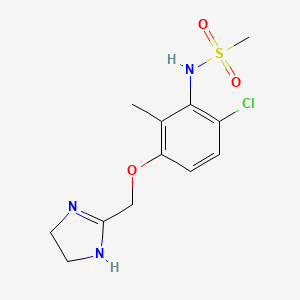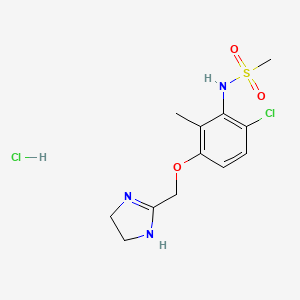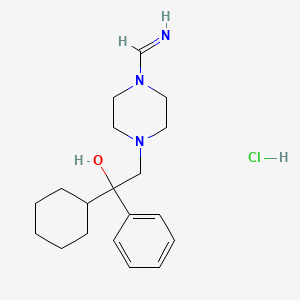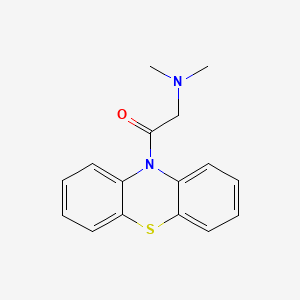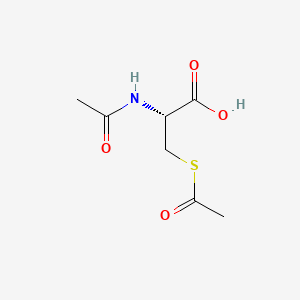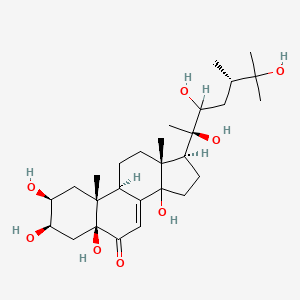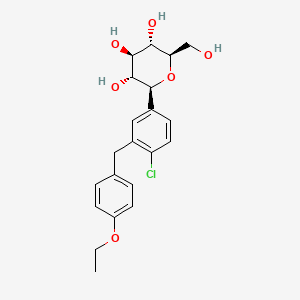
Dapagliflozine
Vue d'ensemble
Description
La dapagliflozine est un médicament principalement utilisé pour traiter le diabète de type 2. Il appartient à la classe des inhibiteurs du cotransporteur sodium-glucose 2. En inhibant ce transporteur, la this compound réduit la réabsorption du glucose dans les reins, ce qui entraîne une augmentation de l'excrétion du glucose dans l'urine. Cela contribue à abaisser le taux de glucose dans le sang. De plus, la this compound est utilisée pour traiter l'insuffisance cardiaque et la maladie rénale chronique .
Applications De Recherche Scientifique
Dapagliflozin has a wide range of scientific research applications:
Chemistry: Used as a model compound to study the behavior of sodium-glucose co-transporter 2 inhibitors.
Biology: Investigated for its effects on glucose metabolism and renal function.
Medicine: Extensively studied for its therapeutic effects in treating type 2 diabetes, heart failure, and chronic kidney disease. .
Mécanisme D'action
Target of Action
Dapagliflozin primarily targets the sodium-glucose cotransporter 2 (SGLT2) . SGLT2 is predominantly expressed in the proximal tubule of the nephron in the kidneys . It is responsible for mediating approximately 90% of glucose reabsorption in the kidneys .
Mode of Action
Dapagliflozin acts as a highly potent, selective, and reversible inhibitor of SGLT2 . By blocking this protein, dapagliflozin prevents glucose reabsorption, leading to glucose excretion in the urine . This process is known as glycosuria , which helps to improve glycemic control .
Biochemical Pathways
Dapagliflozin influences several biochemical pathways. Primarily, it affects glucose metabolism , specifically the glycolysis/gluconeogenesis and pentose phosphate pathways . By inhibiting glucose reabsorption, dapagliflozin indirectly influences these pathways, leading to changes in the body’s glucose levels . Additionally, dapagliflozin has been found to impact the PI3K-Akt-eNOS pathway, which plays a role in angiogenesis .
Pharmacokinetics
Dapagliflozin is rapidly absorbed when administered orally, generally achieving peak plasma concentrations within 2 hours . It has an oral bioavailability of 78% . Dapagliflozin is metabolized predominantly in the liver and kidneys by uridine diphosphate-glucuronosyltransferase-1A9 to the major metabolite dapagliflozin 3-O-glucuronide . The half-life for orally administered dapagliflozin is approximately 12.9 hours .
Result of Action
The primary result of dapagliflozin’s action is improved glycemic control in patients with type 2 diabetes mellitus . By causing glycosuria, dapagliflozin reduces blood glucose levels, which can help manage diabetes . Additionally, dapagliflozin has been shown to have a positive impact on arterial stiffness and contributes to a reduced risk of cardiovascular complications .
Action Environment
Environmental factors can influence the action, efficacy, and stability of dapagliflozin. For instance, the compound is water-soluble and hydrolytically stable in the aquatic environment . In domestic sewage, it is unlikely that dapagliflozin would significantly partition to the sludge solids during wastewater treatment . These environmental factors can impact the distribution and degradation of dapagliflozin in the environment .
Analyse Biochimique
Biochemical Properties
Dapagliflozin plays a crucial role in biochemical reactions by inhibiting the SGLT2 protein, which is predominantly expressed in the proximal renal tubules. This inhibition prevents glucose reabsorption, leading to its excretion through urine. Dapagliflozin interacts with various enzymes and proteins, including sex hormone-binding globulin, transferrin receptor protein 1, disintegrin, metalloprotease-like decysin-1, and apolipoprotein A-IV, increasing their levels. Conversely, it decreases the levels of complement C3, fibronectin, afamin, attractin, xanthine, and uric acid .
Cellular Effects
Dapagliflozin influences various cell types and cellular processes. It enhances insulin sensitivity in hepatic and adipose tissues, leading to improved glucose metabolism. Dapagliflozin also affects cell signaling pathways, such as the MYD88, NLRP3 complex, Leukotrienes/Interleukin 6 axis, and mTORC1/Fox01/3a mediated apoptosis . These interactions result in changes in gene expression and cellular metabolism, contributing to its therapeutic effects.
Molecular Mechanism
At the molecular level, dapagliflozin exerts its effects by binding to the SGLT2 protein, inhibiting its function, and preventing glucose reabsorption in the kidneys. This inhibition leads to increased urinary glucose excretion, mimicking caloric restriction and promoting fat oxidation . Dapagliflozin also influences gene expression by modulating the activity of various transcription factors and signaling pathways, contributing to its beneficial effects on glucose metabolism and insulin sensitivity.
Temporal Effects in Laboratory Settings
In laboratory settings, the effects of dapagliflozin change over time. Studies have shown that dapagliflozin treatment for 12 weeks significantly decreases HbA1c, BMI, and HOMA-IR in patients with type 2 diabetes . The stability and degradation of dapagliflozin in vitro and in vivo settings are crucial for understanding its long-term effects on cellular function. Dapagliflozin has been shown to maintain its efficacy over extended periods, with consistent improvements in metabolic parameters.
Dosage Effects in Animal Models
The effects of dapagliflozin vary with different dosages in animal models. At therapeutic doses, dapagliflozin effectively reduces glucose levels and improves insulin sensitivity. At higher doses, it may cause adverse effects, such as dehydration and electrolyte imbalances. Studies have identified threshold effects, where the benefits of dapagliflozin plateau beyond a certain dosage, emphasizing the importance of optimal dosing for therapeutic efficacy .
Metabolic Pathways
Dapagliflozin is involved in several metabolic pathways, including glycolysis, gluconeogenesis, and the pentose phosphate pathway. It interacts with enzymes such as UGT1A9, which metabolizes dapagliflozin to its major inactive metabolite 3-O-glucuronide . These interactions influence metabolic flux and metabolite levels, contributing to the overall metabolic effects of dapagliflozin.
Transport and Distribution
Dapagliflozin is transported and distributed within cells and tissues through various transporters and binding proteins. It is primarily localized in the kidneys, where it exerts its glucose-lowering effects by inhibiting SGLT2. The distribution of dapagliflozin within other tissues, such as the liver and adipose tissue, also contributes to its metabolic effects .
Subcellular Localization
The subcellular localization of dapagliflozin is primarily in the proximal renal tubules, where it inhibits SGLT2. This localization is crucial for its activity and function, as it directly affects glucose reabsorption in the kidneys. Dapagliflozin may also undergo post-translational modifications that influence its targeting to specific compartments or organelles, further modulating its therapeutic effects .
Méthodes De Préparation
Voies de synthèse et conditions de réaction : La synthèse de la dapagliflozine implique plusieurs étapes clés :
Préparation du réactif de Grignard : La matière première initiale, le 1-chloro-2-(4-éthoxybenzyl)-4-iodobenzène, réagit avec du magnésium en utilisant des granulés d'iode comme initiateur pour préparer un réactif de Grignard.
Réaction de bromation : Le sucre peracétylé réagit avec le bromure d'hydrogène dans une solution d'acide acétique pour préparer le bromure de 2,3,4,6-tétraacétylglucosamine.
Formation du composé intermédiaire : Le réactif de Grignard est ajouté à une solution de méthylbenzène/tétrahydrofurane, suivie de l'ajout d'un catalyseur de terres rares et de bromure de 2,3,4,6-tétraacétylglucosamine, ce qui donne un composé intermédiaire.
Hydrolyse et recristallisation : Le composé intermédiaire subit une hydrolyse alcaline dans une solution de tétrahydrofurane/éthanol/eau d'hydroxyde de sodium, suivie d'une recristallisation pour obtenir la this compound.
Méthodes de production industrielle : La production industrielle de la this compound suit des voies de synthèse similaires, mais à plus grande échelle, en garantissant une grande pureté et un rendement élevé. Le processus implique des mesures strictes de contrôle de la qualité afin de minimiser les impuretés et d'assurer la cohérence du produit final .
Types de réactions :
Oxydation : La this compound peut subir des réactions d'oxydation, conduisant à la formation de métabolites tels que l'oxo this compound.
Réduction : Les réactions de réduction peuvent convertir la this compound en ses formes réduites.
Substitution : Des réactions de substitution peuvent se produire à diverses positions sur la molécule de this compound, conduisant à la formation de différents dérivés.
Réactifs et conditions courants :
Oxydation : Les agents oxydants courants comprennent le peroxyde d'hydrogène et le permanganate de potassium.
Réduction : Des agents réducteurs tels que le borohydrure de sodium et l'hydrure de lithium et d'aluminium sont utilisés.
Substitution : Divers agents halogénants et nucléophiles sont utilisés dans les réactions de substitution.
Principaux produits :
This compound hydroxy benzylique : Formée par hydroxylation.
Oxo this compound : Formée par oxydation.
Deséthyl this compound : Formée par déséthylation.
4. Applications de la recherche scientifique
La this compound a un large éventail d'applications de recherche scientifique :
Chimie : Utilisée comme composé modèle pour étudier le comportement des inhibiteurs du cotransporteur sodium-glucose 2.
Biologie : Investigated for its effects on glucose metabolism and renal function.
Médecine : Étudiée de manière approfondie pour ses effets thérapeutiques dans le traitement du diabète de type 2, de l'insuffisance cardiaque et de la maladie rénale chronique. .
5. Mécanisme d'action
La this compound agit en inhibant le cotransporteur sodium-glucose 2 dans les tubules rénaux proximaux. Ce transporteur est responsable de la réabsorption du glucose depuis la lumière tubulaire. En inhibant ce transporteur, la this compound réduit la réabsorption du glucose, ce qui entraîne une augmentation de l'excrétion du glucose dans l'urine. Cela entraîne une diminution du taux de glucose dans le sang. De plus, la this compound réduit la réabsorption du sodium, ce qui peut influencer plusieurs fonctions physiologiques, notamment l'abaissement de la précharge et de la postcharge du cœur et la régulation négative de l'activité sympathique .
Composés similaires :
- Empagliflozine
- Canagliflozine
- Ipragliflozine
Comparaison :
- Empagliflozine : La this compound et l'empagliflozine sont toutes deux des inhibiteurs du cotransporteur sodium-glucose 2 utilisés pour traiter le diabète de type 2. la this compound a montré un risque plus élevé d'hospitalisation pour insuffisance cardiaque par rapport à l'empagliflozine .
- Canagliflozine : Tout comme la this compound, la canagliflozine est utilisée pour traiter le diabète de type 2 et présente des avantages supplémentaires en réduisant les événements cardiovasculaires. La canagliflozine a été associée à un risque plus élevé d'amputations des membres inférieurs.
- Ipragliflozine : Un autre inhibiteur du cotransporteur sodium-glucose 2 avec des effets hypoglycémiants similaires. la this compound a un profil de sécurité plus favorable en termes d'infections génitales .
La this compound se distingue par ses avantages complets dans le traitement du diabète de type 2, de l'insuffisance cardiaque et de la maladie rénale chronique, ainsi que par son profil de sécurité relativement favorable.
Comparaison Avec Des Composés Similaires
- Empagliflozin
- Canagliflozin
- Ipragliflozin
Comparison:
- Empagliflozin: Both dapagliflozin and empagliflozin are sodium-glucose co-transporter 2 inhibitors used to treat type 2 diabetes. dapagliflozin has shown a higher risk of hospitalization for heart failure compared to empagliflozin .
- Canagliflozin: Similar to dapagliflozin, canagliflozin is used to treat type 2 diabetes and has additional benefits in reducing cardiovascular events. canagliflozin has been associated with a higher risk of lower limb amputations.
- Ipragliflozin: Another sodium-glucose co-transporter 2 inhibitor with similar glucose-lowering effects. dapagliflozin has a more favorable safety profile in terms of genital infections .
Dapagliflozin stands out due to its comprehensive benefits in treating type 2 diabetes, heart failure, and chronic kidney disease, along with its relatively favorable safety profile.
Propriétés
IUPAC Name |
(2S,3R,4R,5S,6R)-2-[4-chloro-3-[(4-ethoxyphenyl)methyl]phenyl]-6-(hydroxymethyl)oxane-3,4,5-triol | |
|---|---|---|
| Source | PubChem | |
| URL | https://pubchem.ncbi.nlm.nih.gov | |
| Description | Data deposited in or computed by PubChem | |
InChI |
InChI=1S/C21H25ClO6/c1-2-27-15-6-3-12(4-7-15)9-14-10-13(5-8-16(14)22)21-20(26)19(25)18(24)17(11-23)28-21/h3-8,10,17-21,23-26H,2,9,11H2,1H3/t17-,18-,19+,20-,21+/m1/s1 | |
| Source | PubChem | |
| URL | https://pubchem.ncbi.nlm.nih.gov | |
| Description | Data deposited in or computed by PubChem | |
InChI Key |
JVHXJTBJCFBINQ-ADAARDCZSA-N | |
| Source | PubChem | |
| URL | https://pubchem.ncbi.nlm.nih.gov | |
| Description | Data deposited in or computed by PubChem | |
Canonical SMILES |
CCOC1=CC=C(C=C1)CC2=C(C=CC(=C2)C3C(C(C(C(O3)CO)O)O)O)Cl | |
| Source | PubChem | |
| URL | https://pubchem.ncbi.nlm.nih.gov | |
| Description | Data deposited in or computed by PubChem | |
Isomeric SMILES |
CCOC1=CC=C(C=C1)CC2=C(C=CC(=C2)[C@H]3[C@@H]([C@H]([C@@H]([C@H](O3)CO)O)O)O)Cl | |
| Source | PubChem | |
| URL | https://pubchem.ncbi.nlm.nih.gov | |
| Description | Data deposited in or computed by PubChem | |
Molecular Formula |
C21H25ClO6 | |
| Source | PubChem | |
| URL | https://pubchem.ncbi.nlm.nih.gov | |
| Description | Data deposited in or computed by PubChem | |
DSSTOX Substance ID |
DTXSID20905104 | |
| Record name | Dapagliflozin | |
| Source | EPA DSSTox | |
| URL | https://comptox.epa.gov/dashboard/DTXSID20905104 | |
| Description | DSSTox provides a high quality public chemistry resource for supporting improved predictive toxicology. | |
Molecular Weight |
408.9 g/mol | |
| Source | PubChem | |
| URL | https://pubchem.ncbi.nlm.nih.gov | |
| Description | Data deposited in or computed by PubChem | |
Mechanism of Action |
Dapagliflozin inhibits the sodium-glucose contransporter 2(SGLT2) which is primarily located in the proximal tubule of the nephron. SGLT2 facilitates 90% of glucose reabsorption in the kidneys and so its inhibition allows for glucose to be excreted in the urine. This excretion allows for better glycemic control and potentially weight loss in patients with type 2 diabetes mellitus. | |
| Record name | Dapagliflozin | |
| Source | DrugBank | |
| URL | https://www.drugbank.ca/drugs/DB06292 | |
| Description | The DrugBank database is a unique bioinformatics and cheminformatics resource that combines detailed drug (i.e. chemical, pharmacological and pharmaceutical) data with comprehensive drug target (i.e. sequence, structure, and pathway) information. | |
| Explanation | Creative Common's Attribution-NonCommercial 4.0 International License (http://creativecommons.org/licenses/by-nc/4.0/legalcode) | |
CAS No. |
461432-26-8 | |
| Record name | Dapagliflozin | |
| Source | CAS Common Chemistry | |
| URL | https://commonchemistry.cas.org/detail?cas_rn=461432-26-8 | |
| Description | CAS Common Chemistry is an open community resource for accessing chemical information. Nearly 500,000 chemical substances from CAS REGISTRY cover areas of community interest, including common and frequently regulated chemicals, and those relevant to high school and undergraduate chemistry classes. This chemical information, curated by our expert scientists, is provided in alignment with our mission as a division of the American Chemical Society. | |
| Explanation | The data from CAS Common Chemistry is provided under a CC-BY-NC 4.0 license, unless otherwise stated. | |
| Record name | Dapagliflozin [USAN:INN] | |
| Source | ChemIDplus | |
| URL | https://pubchem.ncbi.nlm.nih.gov/substance/?source=chemidplus&sourceid=0461432268 | |
| Description | ChemIDplus is a free, web search system that provides access to the structure and nomenclature authority files used for the identification of chemical substances cited in National Library of Medicine (NLM) databases, including the TOXNET system. | |
| Record name | Dapagliflozin | |
| Source | DrugBank | |
| URL | https://www.drugbank.ca/drugs/DB06292 | |
| Description | The DrugBank database is a unique bioinformatics and cheminformatics resource that combines detailed drug (i.e. chemical, pharmacological and pharmaceutical) data with comprehensive drug target (i.e. sequence, structure, and pathway) information. | |
| Explanation | Creative Common's Attribution-NonCommercial 4.0 International License (http://creativecommons.org/licenses/by-nc/4.0/legalcode) | |
| Record name | Dapagliflozin | |
| Source | EPA DSSTox | |
| URL | https://comptox.epa.gov/dashboard/DTXSID20905104 | |
| Description | DSSTox provides a high quality public chemistry resource for supporting improved predictive toxicology. | |
| Record name | (1S)-1,5-anhydro-1-C-[4-chloro-3-[(4-ethoxyphenyl)methyl]phenyl]-D-glucitol | |
| Source | European Chemicals Agency (ECHA) | |
| URL | https://echa.europa.eu/information-on-chemicals | |
| Description | The European Chemicals Agency (ECHA) is an agency of the European Union which is the driving force among regulatory authorities in implementing the EU's groundbreaking chemicals legislation for the benefit of human health and the environment as well as for innovation and competitiveness. | |
| Explanation | Use of the information, documents and data from the ECHA website is subject to the terms and conditions of this Legal Notice, and subject to other binding limitations provided for under applicable law, the information, documents and data made available on the ECHA website may be reproduced, distributed and/or used, totally or in part, for non-commercial purposes provided that ECHA is acknowledged as the source: "Source: European Chemicals Agency, http://echa.europa.eu/". Such acknowledgement must be included in each copy of the material. ECHA permits and encourages organisations and individuals to create links to the ECHA website under the following cumulative conditions: Links can only be made to webpages that provide a link to the Legal Notice page. | |
| Record name | DAPAGLIFLOZIN | |
| Source | FDA Global Substance Registration System (GSRS) | |
| URL | https://gsrs.ncats.nih.gov/ginas/app/beta/substances/1ULL0QJ8UC | |
| Description | The FDA Global Substance Registration System (GSRS) enables the efficient and accurate exchange of information on what substances are in regulated products. Instead of relying on names, which vary across regulatory domains, countries, and regions, the GSRS knowledge base makes it possible for substances to be defined by standardized, scientific descriptions. | |
| Explanation | Unless otherwise noted, the contents of the FDA website (www.fda.gov), both text and graphics, are not copyrighted. They are in the public domain and may be republished, reprinted and otherwise used freely by anyone without the need to obtain permission from FDA. Credit to the U.S. Food and Drug Administration as the source is appreciated but not required. | |
Retrosynthesis Analysis
AI-Powered Synthesis Planning: Our tool employs the Template_relevance Pistachio, Template_relevance Bkms_metabolic, Template_relevance Pistachio_ringbreaker, Template_relevance Reaxys, Template_relevance Reaxys_biocatalysis model, leveraging a vast database of chemical reactions to predict feasible synthetic routes.
One-Step Synthesis Focus: Specifically designed for one-step synthesis, it provides concise and direct routes for your target compounds, streamlining the synthesis process.
Accurate Predictions: Utilizing the extensive PISTACHIO, BKMS_METABOLIC, PISTACHIO_RINGBREAKER, REAXYS, REAXYS_BIOCATALYSIS database, our tool offers high-accuracy predictions, reflecting the latest in chemical research and data.
Strategy Settings
| Precursor scoring | Relevance Heuristic |
|---|---|
| Min. plausibility | 0.01 |
| Model | Template_relevance |
| Template Set | Pistachio/Bkms_metabolic/Pistachio_ringbreaker/Reaxys/Reaxys_biocatalysis |
| Top-N result to add to graph | 6 |
Feasible Synthetic Routes
Q1: What is the primary mechanism of action of dapagliflozin?
A1: Dapagliflozin selectively inhibits SGLT2, a protein primarily located in the S1 segment of the proximal convoluted tubule in the kidneys []. SGLT2 is responsible for the majority of glucose reabsorption from the glomerular filtrate back into the bloodstream. By inhibiting SGLT2, dapagliflozin promotes urinary glucose excretion, thereby lowering blood glucose levels independently of insulin secretion or sensitivity [].
Q2: Does dapagliflozin affect other SGLT transporters in the body?
A2: Dapagliflozin demonstrates high selectivity for SGLT2 over SGLT1, another glucose transporter found in the intestines and kidneys []. This selectivity is crucial as SGLT1 inhibition can lead to gastrointestinal side effects.
Q3: How does dapagliflozin impact glucose homeostasis in the liver?
A3: While dapagliflozin primarily acts in the kidneys, research suggests it can influence hepatic glucose metabolism. Studies in obese Zucker rats show dapagliflozin increases hepatic fatty acid oxidation and ketone body formation []. This effect is attributed to the increased reliance on fatty acids as fuel in the context of dapagliflozin-induced glycosuria, mimicking a fasting state [].
Q4: Beyond its glucose-lowering effects, what other potential benefits has dapagliflozin demonstrated in preclinical studies?
A4: Preclinical studies indicate dapagliflozin may offer benefits beyond glycemic control. These include:
- Cardioprotection: Research suggests dapagliflozin may protect against doxorubicin and trastuzumab-induced cardiotoxicity by reducing oxidative stress and inflammation in cardiomyocytes [, ].
- Neuroprotection: Studies in diabetic mice indicate dapagliflozin may protect retinal neural and vascular function by reducing inflammation and improving glycemic control [].
- Renal Protection: While some research suggests dapagliflozin may increase the risk of certain renal events [], other studies indicate potential benefits. For instance, dapagliflozin has been shown to attenuate contrast-induced acute kidney injury by regulating the HIF-1α/HE4/NF-κB pathway [].
- Testicular Function: Dapagliflozin has been observed to improve testicular structure and sperm quality in diabetic mice, potentially through the activation of the GLP-1R/PI3K/Akt signaling pathway [].
Q5: What is the molecular formula and weight of dapagliflozin?
A5: The molecular formula of dapagliflozin propanediol monohydrate is C21H25ClO6 • C3H8O2, and its molecular weight is 480.9 g/mol. Information regarding the molecular formula and weight of dapagliflozin formate is unavailable in the provided abstracts.
Q6: How is dapagliflozin metabolized in the body?
A6: Dapagliflozin is primarily metabolized by UGT1A1, an enzyme involved in glucuronidation, to an inactive metabolite, dapagliflozin 3-O-glucuronide [].
Q7: What is the primary route of elimination for dapagliflozin?
A7: Dapagliflozin is mainly eliminated through the kidneys with a mean plasma terminal half-life of 12.9 hours after a single 10 mg oral dose [].
Q8: Has research investigated the pharmacokinetic profile of dapagliflozin formate (DAP-FOR)?
A8: A study comparing dapagliflozin formate (DAP-FOR) to dapagliflozin propanediol monohydrate (DAP-PDH) in healthy subjects showed DAP-FOR is rapidly converted into dapagliflozin, resulting in very low DAP-FOR exposure []. This rapid conversion leads to comparable pharmacokinetic profiles of dapagliflozin between the two formulations.
Q9: Are there specific patient populations where dapagliflozin's efficacy may be influenced?
A9: Research suggests the efficacy of dapagliflozin may vary depending on patient characteristics:
- Baseline Blood Pressure: Dapagliflozin's benefits on heart failure and renal outcomes were consistent across different baseline systolic blood pressure categories, suggesting its efficacy is independent of blood pressure levels [].
- Kidney Function: In patients with heart failure and mildly reduced or preserved ejection fraction, dapagliflozin's benefits on the primary outcome of cardiovascular death or worsening heart failure were consistent regardless of baseline kidney function [].
- Diet: The efficacy of dapagliflozin might be attenuated in individuals consuming a low-carbohydrate diet compared to a normal carbohydrate diet []. Studies in mice suggest this difference may be attributed to variations in liver metabolism between the two dietary groups.
Q10: What are some promising areas of ongoing research related to dapagliflozin?
A13: * Biomarkers: Identifying biomarkers to predict treatment response, monitor efficacy, and assess the risk of adverse events is crucial. Ongoing research focuses on discovering reliable biomarkers for dapagliflozin therapy [, ].* Drug Delivery: Developing targeted drug delivery strategies could potentially enhance dapagliflozin's efficacy and minimize off-target effects [].* Combination Therapies: Exploring the synergistic potential of dapagliflozin with other antidiabetic agents, such as GLP-1 receptor agonists [], holds promise for optimizing glycemic control and patient outcomes.
Avertissement et informations sur les produits de recherche in vitro
Veuillez noter que tous les articles et informations sur les produits présentés sur BenchChem sont destinés uniquement à des fins informatives. Les produits disponibles à l'achat sur BenchChem sont spécifiquement conçus pour des études in vitro, qui sont réalisées en dehors des organismes vivants. Les études in vitro, dérivées du terme latin "in verre", impliquent des expériences réalisées dans des environnements de laboratoire contrôlés à l'aide de cellules ou de tissus. Il est important de noter que ces produits ne sont pas classés comme médicaments et n'ont pas reçu l'approbation de la FDA pour la prévention, le traitement ou la guérison de toute condition médicale, affection ou maladie. Nous devons souligner que toute forme d'introduction corporelle de ces produits chez les humains ou les animaux est strictement interdite par la loi. Il est essentiel de respecter ces directives pour assurer la conformité aux normes légales et éthiques en matière de recherche et d'expérimentation.


![N-(tert-butyl)-N'-[4-(1H-imidazol-4-yl)phenyl]imidoformamide](/img/structure/B1669729.png)
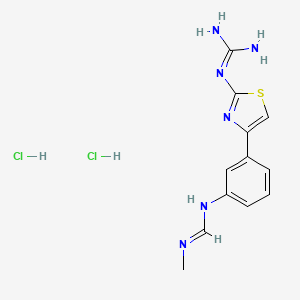
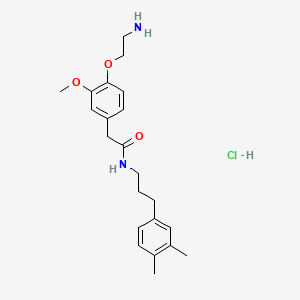


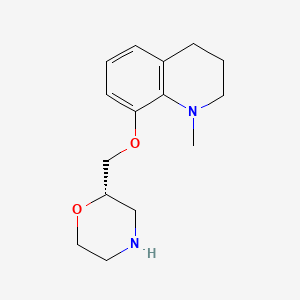
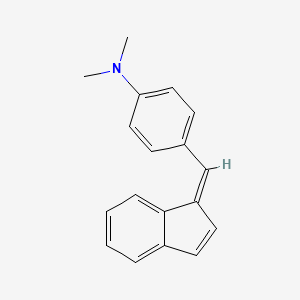
![ethyl 3-[[2-[[4-[(Z)-N'-hexoxycarbonylcarbamimidoyl]anilino]methyl]-1-methylbenzimidazole-5-carbonyl]-pyridin-2-ylamino]propanoate;methanesulfonic acid](/img/structure/B1669742.png)
